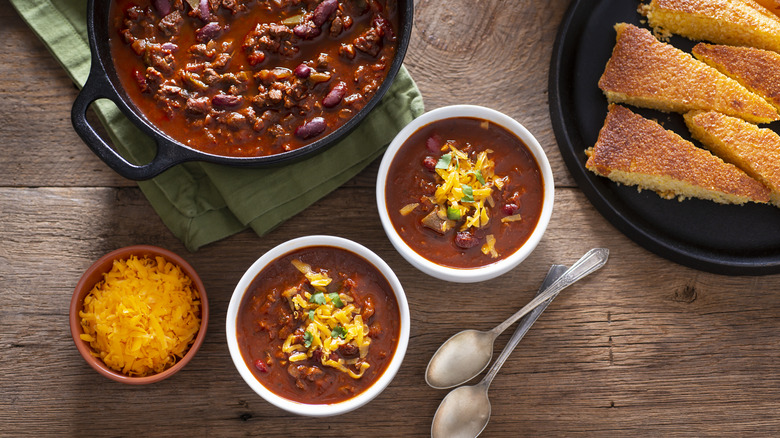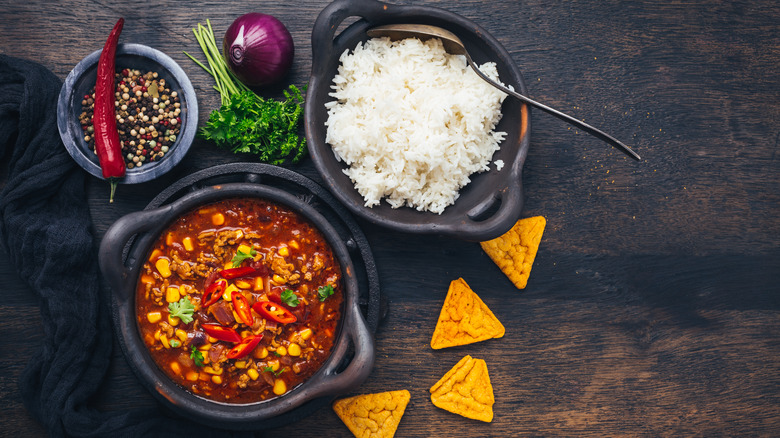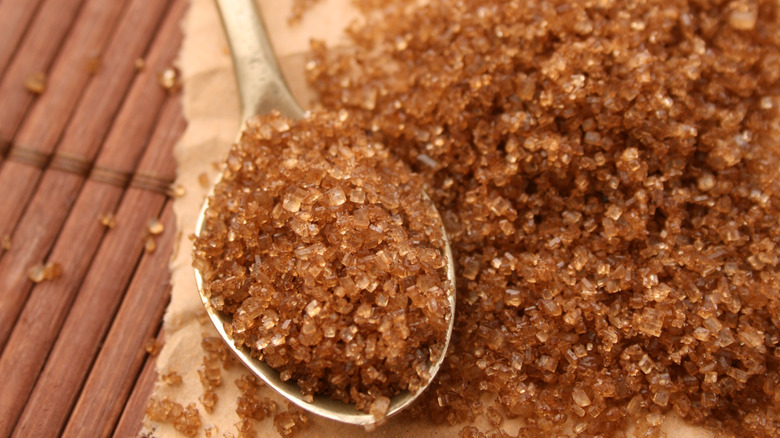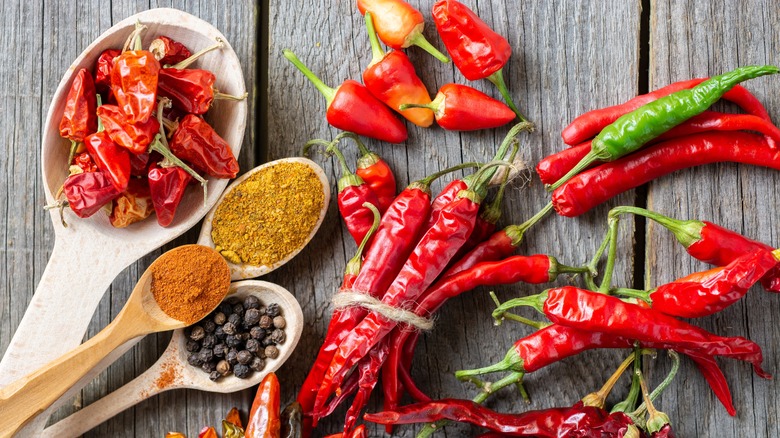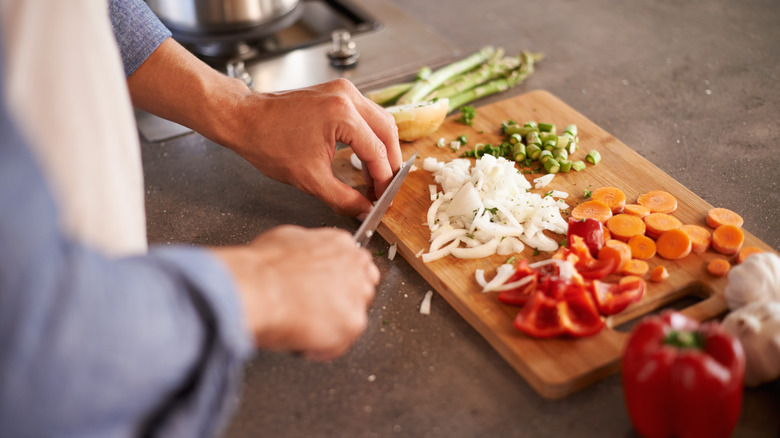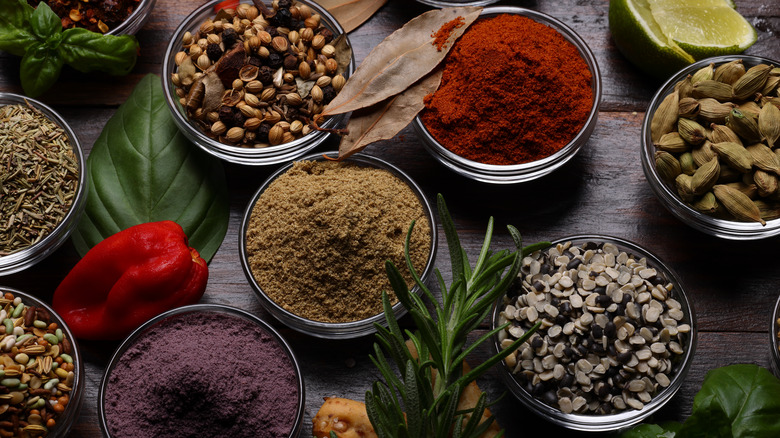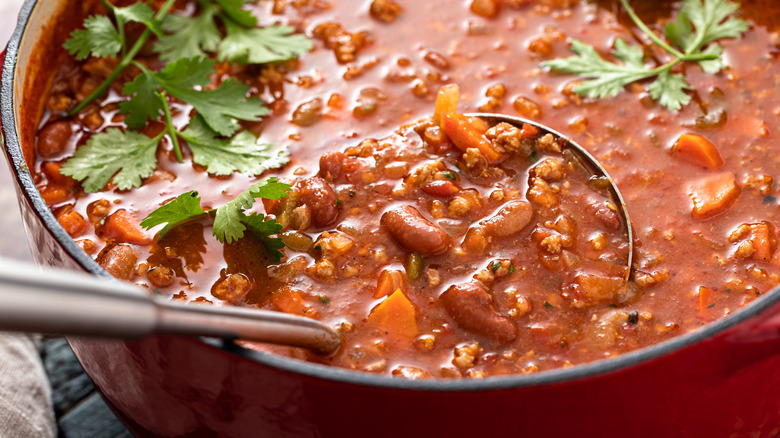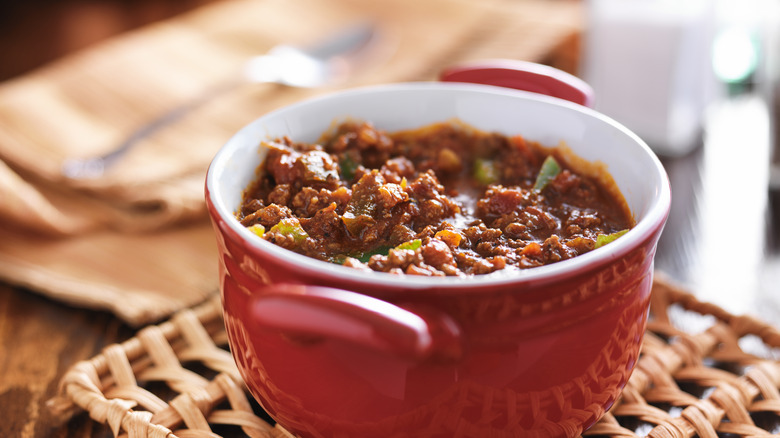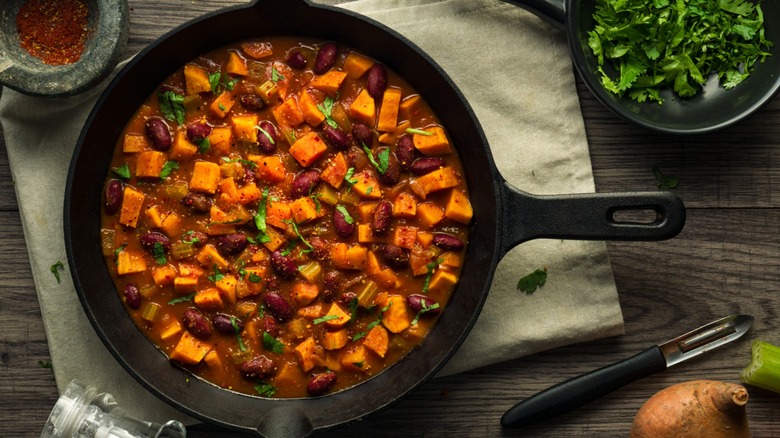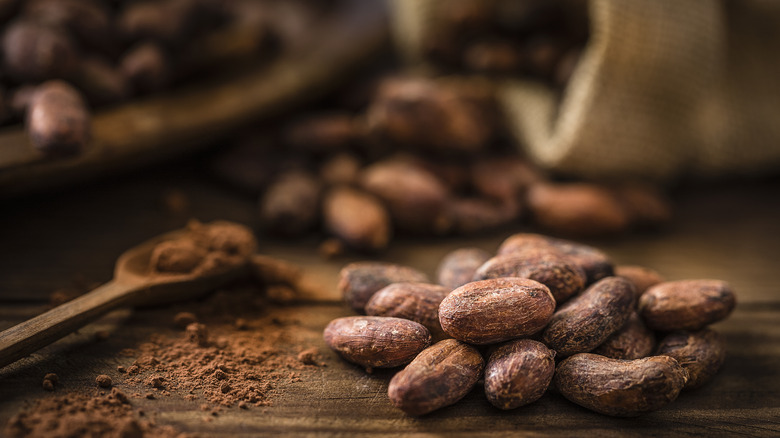12 Ways To Take Canned Chili To The Next Level
It's hard to think of a better dish for a cold night than a warm bowl of chili. The temperature and spices are sure to have you feeling cozy in no time. On top of that, common chili ingredients like ground meat and beans are very filling, making it a satiating meal. But, while chili is delicious, you may not be in the mood to make it from scratch. Homemade slow cooker chili is delicious, but it's time-consuming. If you want to enjoy a bowl of chili but don't want to spend that much time cooking, you can easily pick up a can of your favorite style of chili to heat up and enjoy for lunch or dinner.
Canned chili is an easy way to enjoy this classic comfort food in minutes. Instead of combining all the ingredients, cooking, and simmering, all you have to do is open the can and pour the chili into a saucepan to heat on the stovetop or bowl to warm in the microwave. It's quick and simple, and the best part is you can make canned chili taste amazing.
Just because you opt for canned chili doesn't mean that it can't taste as good as homemade. There are so many ingredients and add-ons that you can try to take your canned chili to the next level. By researching and experimenting with classic chili add-ons as well as more outside-the-box ingredient ideas, we've compiled some of the best ways to enhance your canned chili.
Don't forget your favorite chili toppings
Adding toppings is one of the simplest and most effective ways to elevate your bowl of chili. This is a great option if you're not too comfortable cooking but still want to make your canned chili delicious. You don't have to add any ingredients to the recipe; instead, just heat the chili according to the instructions on the can and serve.
After ladling the chili into serving bowls, you can get creative by piling on any number of your favorite toppings. There are plenty of classic add-ons to choose from. Warm chili tastes amazing with shredded cheddar cheese melted over the top. You can also add sour cream and sliced avocado for a rich, creamy addition. Bring in some crunch with corn chips or tortilla strips. Freshly sliced tomatoes, red onion, jalapeño peppers, and cilantro are other great ways to dress up your serving of chili.
If you're making a family meal or serving a large group, you can make things fun by putting together a DIY chili bar. Put out all your topping options in separate bowls and let everyone pick what they want for their chili. This build-your-own chili bowl option is great if you have people with different flavor preferences. Rather than altering the whole batch of chili to try to make everyone happy, let each individual add what they prefer to their bowl.
Deepen the flavor by adding beer
Beer isn't just for drinking. It's also an excellent ingredient that you can use to enhance the flavor of a variety of dishes. The malty and sweet flavor notes from beer are perfect for enriching the flavor of your canned chili. This is an especially great option for classic beef chili, as the sugars in the beer complement the meat's natural flavors. You also don't have to worry about the chili tasting boozy or getting you drunk, as practically all the alcohol will cook out. Just be sure to bring the chili to a low boil and let it simmer for several minutes before serving to cook out the alcohol content.
When choosing beer for your chili, it's best to use one with low hops, such as a porter, lager, or stout. You can pick what kind you'd prefer based on the flavor profile you're going for. For instance, a pale lager will bring in a lighter, crisper flavor that doesn't overwhelm the other chili ingredients. Stouts, on the other hand, are darker and have a slightly nutty flavor that's more bold. And a porter falls somewhere between the two.
Adjust how much beer you add according to your personal taste and batch size. If you're heating up one can of chili for yourself, you'll only need a splash of beer, but if you're making a whole pot, you might add a full 12-ounce bottle.
Sweeten the pot with a dash of brown sugar
Similar to adding beer, another way to enrich your chili and play with the balance of sweet and spicy is by adding brown sugar to the chili pot. Brown sugar is often used in meat marinades, glazes, and sauces because it helps to caramelize and boost the natural flavors in the meat. In stew, soup, and chili recipes, the sugar also cuts through the spicy and tangy flavors to offer a more well-rounded and nuanced taste.
Although you could use white sugar, it won't work quite as well. Brown sugar has darker, richer notes that better play off the spices and other hearty ingredients in chili.
As a word of caution, be sure to be light-handed when you add sugar. While a hint of sweetness and caramelized flavor enriches chili, it's key not to add too much. You don't want to tip the scale and make your savory dish taste sickly sweet. To avoid this, add a little at a time and taste test as you go if necessary. 1-2 tablespoons of brown sugar is plenty for a full pot of chili. If you're only preparing 1-2 servings, then you'll want to decrease that amount accordingly.
Turn the heat up with more chiles
If you like your chili to come with an extra kick of heat, don't be scared to add some chile peppers to the mix. There are different kinds of peppers that you can use depending on the flavor profile you want and the level of heat you're comfortable with. For a mild spiciness, go with something like Fresno peppers, which fall between 2,500 and 10,000 on the Scoville heat scale. Just a notch above that is jalapeño peppers, falling between 6,000 and 11,000.
Of course, if spicy food is fine for you, feel free to get more adventurous with Serrano (10,000 to 25,000 Scoville rating), Cayenne (30,000 to 50,000 Scoville rating), or Tabasco (30,000 to 50,000. And if you want genuinely eye-watering levels of spice, you can even add Habanero pepper, which can fall anywhere between 100,000 to 325,000 on the Scoville scale.
There are a few tips to keep in mind when adding peppers. Firstly, the riper they are, the hotter they will be. Second, for the best taste, you'll want to remove the pepper seeds, which are often bitter. Third, if you're using fresh peppers, try toasting them before adding to the chili. Lastly, if you want the flavor but want to avoid biting down on a spicy chunk of pepper, you can puree the chiles before adding them to your chili.
Incorporate flavorful vegetables
Most canned chili mixes include vegetables like onion and some sort of tomato paste or tomato sauce. But you can freshen up those flavors and add more variety by incorporating more vegetables into the blend. As mentioned above, chile peppers are a great option for spice, but there are many other flavorful vegetables that can make a world of difference in your canned chili.
Firstly, you can add diced yellow onion and garlic for a more bold, aromatic flavor. Cook these ingredients separately in oil until the onion is translucent and the garlic is fragrant before adding to the chili pot. Some other vegetables you can try are corn, mushrooms, diced tomatoes, zucchini, bell pepper, or spinach. Diced sweet potatoes can also make a surprising and delicious addition. Cook the potatoes separately until fork tender before adding to the dish.
You can use either fresh or canned vegetables, depending on your preference and the ingredients you have on hand. Thoroughly drain and rinse any canned vegetables before adding them to the chili recipe. Any one of these vegetable options or a mix of a few of them will completely transform your easy chili.
Make your own spice blend
Just because you are preparing store-bought, canned food doesn't mean you can't make the recipe your own. One of the easiest ways to make canned food taste fresh and homemade is by adding aromatic spices. Although canned chili will already have some seasonings, fresh herbs and spices will add bolder flavor.
You can upgrade your chili using ingredients you likely already have on your spice rack, such as chili powder, ground cumin, onion powder, garlic powder, smoked paprika, and cayenne pepper. Be sure to use a light hand while adding seasonings, as you want to avoid adding too much of one and ruining your pot of chili. This is especially good to remember when adding stronger spices such as cayenne pepper, which you likely only need 1/4-1/2 teaspoon of to season your chili.
A trick to make your spices even more effective is by toasting them before you add them to the recipe. To do this, you'll want to use whole spices (not ground). Add the spices to a warm skillet over medium heat and stir to evenly toast them. Chef Floyd Cardoz explained to Tasting Table that toasting spices ahead of cooking with them helps to enhance their taste. "It's heat that really wakes up those aromatic oils," Cardoz said.
Why not add bacon?
Bacon lovers know you can't beat the sweet and salty flavor this meat brings to recipes. Adding bacon pieces is an excellent way to level up many comfort food dishes, and chili is no exception — delicious bites of smoky bacon taste incredible with the cozy, savory flavors of chili.
To prepare bacon for the chili, add slices of uncooked bacon to a cast iron skillet or Dutch oven before heating the chili. Cook the bacon over medium heat for 3-5 minutes on each side, using tongs to flip them halfway through the cooking time. Once the bacon is cooked, you can remove it to a paper towel-lined plate to cool. Break the cooked bacon into bacon bits to add to your canned chili while heating. Serve when the chili and bacon are warmed through.
If you want a slightly healthier version of this, you can always use turkey bacon. Or, if you're making vegan chili, keep the recipe meat-free with your favorite plant-based bacon substitute.
Bring in delicious, smokey flavor
You can make canned chili taste like you made it with smoked meat by adding one secret ingredient. Liquid smoke is an excellent way to give dishes a woodsy, smokey taste without the equipment and time it takes to smoke meat.
If you're unfamiliar with it, liquid smoke is an ingredient that you can find in the condiments section at your grocery store. It's made by capturing the smoke from burning wood and condensing that smoke into a liquid that you can add to recipes. You can add it to chili to mimic the smoky flavor of BBQ.
Some tips to keep in mind are that a little goes a long way with this condiment. If you're making a pot of chili, two teaspoons should be plenty. Do even less if you're only heating up a serving or two. And although liquid smoke is an effective flavor ingredient, it's not to everyone's taste. If you're not a fan of liquid smoke but want to give your dish a smoked wood flavor, try using smoked paprika or a dash of chipotle chili powder instead.
Create a more hearty dish with meat
Whether you're using a can of meatless, vegetarian chili or canned chili that already has ground beef or sausage, you can take the savory flavor up a notch by adding freshly cooked meat to the dish. Traditional chili is typically made with beef. Depending on your preference, ground beef or cubes of chuck roast taste wonderful in the stew-like dish.
For ground beef, add the meat to a hot skillet with a bit of oil. Use a wooden spoon to stir and break apart the meat until well browned. You can prepare the meat with sauteed onion, garlic, and your choice of seasonings to enhance the flavor. Once the ground beef is cooked, add it to the canned chili and heat the recipe.
Just like with ground beef, you'll need to cook chuck roast before adding it to your chili. Slice your chuck roast into bite-sized cubes. Season the beef pieces and add them to a skillet with one tablespoon of oil. Cook until thoroughly browned on all sides. Then, cook the chili at a low simmer with the beef in the pot. Keep in mind that your beef needs to reach an internal temperature of 145 F before it's considered safe to eat.
Try meatless protein
You can still add flavor and healthy protein if you're making vegetarian chili and want to keep the dish meatless. Chili is actually a great option for vegan or vegetarian diets because it has plenty of flavor from tomato sauce, chiles, and spices. Bean chilis are also an excellent source of meatless protein since the beans are rich in both fiber and protein.
Along with the beans likely already included in your canned chili, you can incorporate other varieties of meatless protein. One option is just adding more beans to the mixture. You can drain and rinse canned pinto beans, kidney beans, or black beans to your canned dinner. Not only does this add more protein, but it's a good way to make your can of chili go further and serve a few people. Other legumes, such as chickpeas and lentils, are easy to incorporate into chili and bring their own flavor and extra protein. Outside of legumes, some other vegan proteins to consider are sweet potatoes or Russet potatoes, Quinoa, wild rice, tofu, and edamame.
If you want to keep the recipe meatless but don't mind eating dairy, your options open up a little more. You can top the chili off with cottage cheese or a spoonful of plain Greek yogurt for a dose of creamy and delicious vegetarian protein.
Highlight the chile flavor with unsweetened cocoa powder
This advice may sound strange at first, but the results speak for themselves. You can enhance the flavor of your chili recipe by stirring a dash of cocoa powder into the pot. Cocoa powder isn't only a dessert ingredient; you can also use it in savory dishes like this one. The rich flavor from cocoa plays off of the chiles, bringing out their naturally spiced and savory flavor to every bite a flavorful sensation.
If you're still skeptical, rest assured that this flavor combination is tried and true. Chocolate and chile peppers have been used together for centuries, starting in Mexico and Central America. Just think of Mexican hot chocolate. In this beloved hot drink, chile powder is used to highlight the rich chocolate flavors. Adding a dash of cocoa powder has the inverse effect of boosting the chile flavor.
Using cocoa powder is not intended to make your dinner recipe taste like chocolate. It's used to add depth of flavor and enrich the ingredients already in the recipe. To accomplish this, be sure to opt for unsweetened cocoa powder and add a small amount so as not to make the flavor overwhelming. Use 1-2 tablespoons for a large pot or 1 teaspoon if you're only heating up a single can of chili.
Use coffee as your secret ingredient
Coffee can be more than your favorite morning drink. It's also an excellent flavor enhancer for both sweet and savory recipes. Coffee is often used in baked goods, especially for chocolate recipes such as chocolate cake and brownies. In the case of desserts, the acidity of the coffee highlights the sweet flavors in the ingredients. However, it acts differently in chili, instead boosting the warm spices. The deep, earthy flavor of the coffee enhances the spices and savory ingredients in your chili recipe for the ultimate delicious and cozy dish.
When adding coffee to your chili, you can either use espresso powder or brewed coffee. Follow the can instructions to heat your chili on the stovetop. As the dish is warming up, you can scoop a small spoon of instant espresso powder into the pot. Or, pour in a little brewed coffee. Using brewed coffee is a great option if you have any leftovers from the morning. After brewing a pot of coffee in the morning, keep any you didn't drink in the fridge to use in your chili later that day. When adding the coffee, thoroughly mix it into the chili. While this secret ingredient does a great job enhancing the rich flavor in your chili, it's important to blend it so that you don't end up with pockets of strong coffee flavor.
